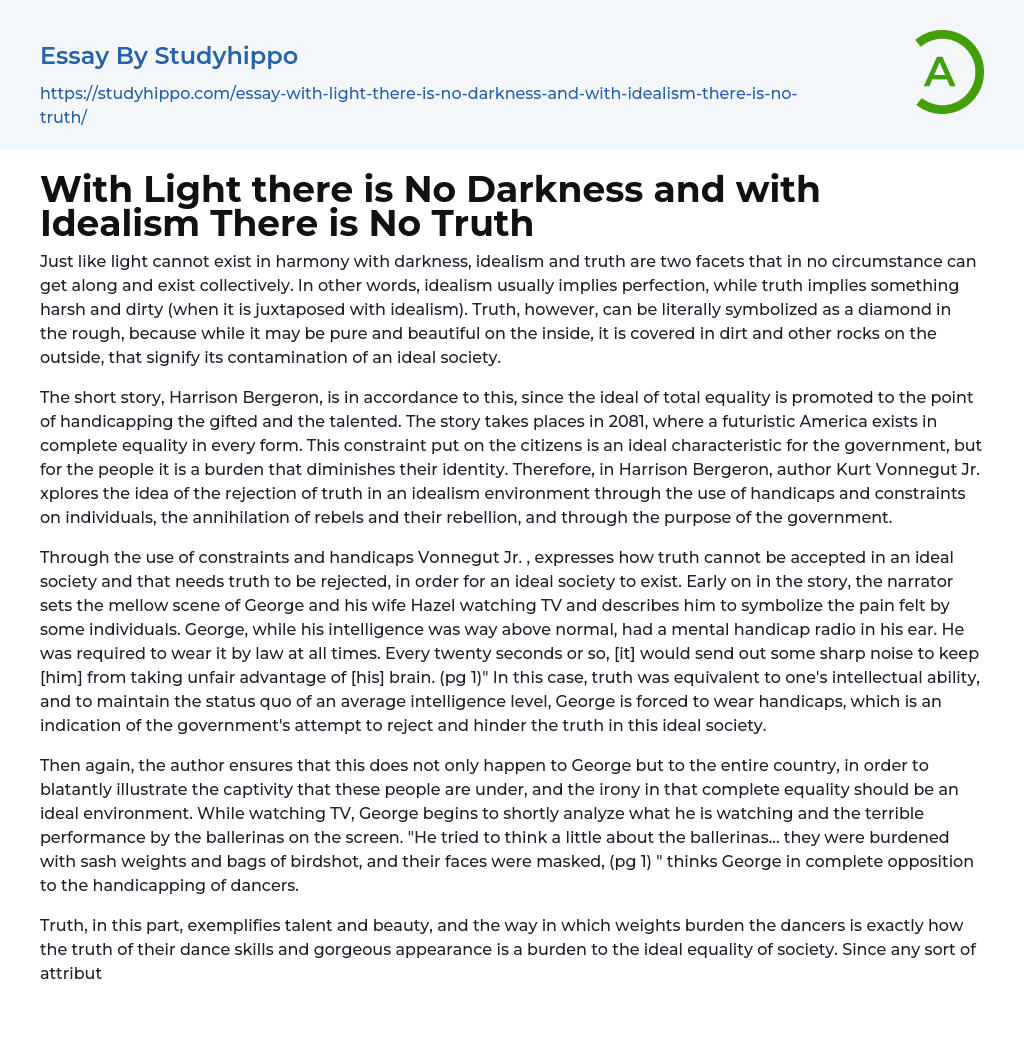

With Light there is No Darkness and with Idealism There is No Truth Essay Example
Just as light and darkness cannot coexist, idealism and truth are incompatible facets. Idealism implies perfection, whereas truth reveals harsh realities. Thus, truth is akin to a diamond in the rough; internally pure and beautiful, yet externally marred by dirt and rocks, which symbolize its contamination in an ideal society.
The concept of total equality is taken to an extreme in the short story "Harrison Bergeron". Set in 2081, a futuristic America enforces equality in every aspect, even handicapping those who are gifted and talented. Although the government sees this as an ideal characteristic, it becomes a burden that erodes individual identity for the people. Author Kurt Vonnegut Jr. explores the theme of rejecting truth in an idealistic society by using handicaps and constraints on individuals, annihilating rebels and their rebellion, and examin
...ing the government's purpose.
In Vonnegut Jr.'s story, the use of constraints and handicaps conveys the idea that truth cannot be accepted in an ideal society. Vonnegut Jr. suggests that for an ideal society to exist, truth needs to be rejected. The narrator introduces George, who is portrayed as a symbol of pain experienced by certain individuals. Despite his above-average intelligence, George is burdened with a mental handicap radio that he is legally required to wear at all times. This device emits sharp noises every twenty seconds or so, preventing him from exploiting his intelligence unfairly. This situation equates truth with intellectual ability. By forcing George to wear handicaps, the government in this ideal society is attempting to reject and impede the truth.
The author emphasizes that the captivity experienced by George is not unique to
him alone but extends to the entire country. This serves to clearly demonstrate the irony that an ideal environment of complete equality should result in such constraints on individuals. While George watches TV, he briefly analyzes the poor performance of the ballerinas on screen. In contrast to the handicapping of dancers, George contemplates the burden they carry with sash weights and bags of birdshot, as well as their masked faces (pg 1).
The text discusses how truth represents talent and beauty. It highlights that the burden on dancers, caused by weights, serves as a metaphor for the burden society faces due to the exceptional dance skills and stunning appearances of individuals. The author aims to demonstrate the stark contrast between idealism and reality, as any attribute that exceeds societal standards is condemned. Ultimately, the author illustrates how this supposedly "perfect" society rejects individual success through non-violent but detrimental measures such as handicaps and constraints.
The author restates his position on the rejection of truth by idealism in a peaceful manner. However, this changes as rebels attempt a rebellion and are annihilated. Towards the end of the story, Harrison Bergeron and his empress share a genuine moment that breaks the rules of expressing talents and beauty. This demonstrates the civilization's tolerance towards anything that threatens equality. Harrison and the empress engage in various movements such as reeling, whirling, swiveling, flouncing, and spinning. They also share a long kiss. Suddenly, the Handicapper General enters the studio with a double-barreled ten-gauge shotgun and fires twice, killing them instantly. This magical scene displays truth through the love between Harrison and his empress, their appearance, dance, and
physical talents.
The government not only despises this act of defiance, but they also dispatch a general to eradicate any rebellion and its instigators. It is evident that in this society, any form of truth is eventually rejected and completely obliterated. Ultimately, Kurt Vonnegut Jr. portrays how idealism rejects the truth by the government's annihilation of anything opposing its regulations and those involved in it.
The author's story highlights how idealism rejects truth through the unique use and purpose of the government. The author explicitly demonstrates this by showcasing the beauty and talent of individuals in the society. One example is a ballerina who is described as extraordinarily beautiful, strong, and graceful. Another example is Harrison Bergeron, a fourteen-year-old genius and athlete who is also deemed extremely dangerous. These portrayals emphasize that individual beauty and talent represent the truth in this society. However, the subsequent murder of these two individuals reveals that the government's sole intention is to reject and diminish the truth of individual success. This theme of suppressing individual success is reinforced, demonstrating the government's efforts to preserve an ideal society by eliminating any expression of progress or achievement by individuals.
The narrator initially introduces the setting by explaining the job duties of the Handicapper agents. They are responsible for maintaining equality, which is achieved through the Constitution and constant monitoring by the agents of the United States Handicapper General (pg 1). The author further emphasizes that any form of individual uniqueness is considered as the truth, while the government and its agents are committed to suppressing this truth using any means necessary. By depicting the government's role in rejecting
truth, the author highlights its impact on an ideal society.
Author Kurt Vonnegut Jr. explores the idea of truth rejection in an ideal society through various means. One approach involves placing constraints and handicaps on individuals, which reveals the struggles they face. By subtly constraining and handicapping them, Vonnegut Jr. demonstrates how idealism rejects truth. The story also highlights the rejection of truth through the destruction of rebels and their rebellion, as exemplified by Harrison and his empress. The government's purpose and actions play a crucial role in embodying the rejection of truth in this society. Through their destructive actions towards individuals and their successes, they bring forth the rejection of truth. Throughout his work, Vonnegut Jr. implies the detrimental effect that individual truths have on an ideal society, while also suggesting that these truths have enlightening effects on individuals.



